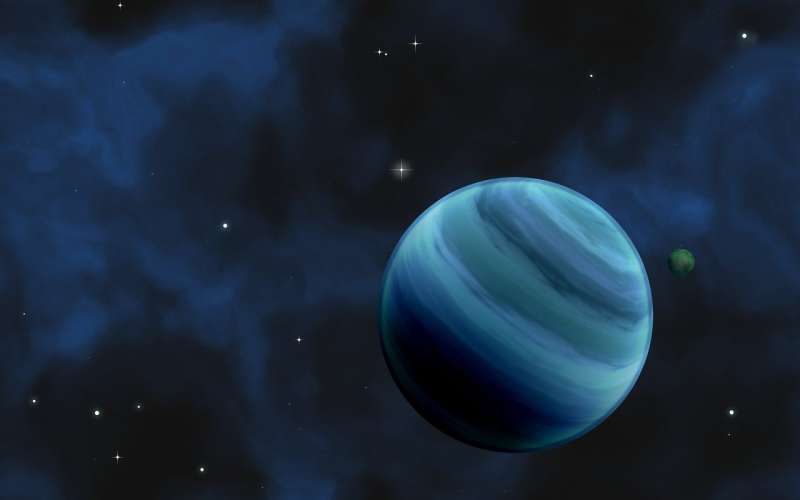Simulations explain giant exoplanets with eccentric, close-in orbits

As planetary systems evolve, gravitational interactions between planets can fling some of them into eccentric elliptical orbits around the host star, or even out of the system altogether. Smaller planets should be more susceptible to this gravitational scattering, yet many gas giant exoplanets have been observed with eccentric orbits very different from the roughly circular orbits of the planets in our own solar system.
Surprisingly, the planets with the highest masses tend to be those with the highest eccentricities, even though the inertia of a larger mass should make it harder to budge from its initial orbit. This counter-intuitive observation prompted astronomers at UC Santa Cruz to explore the evolution of planetary systems using computer simulations. Their results, reported in a paper published in Astrophysical Journal Letters, suggest a crucial role for a giant-impacts phase in the evolution of high-mass planetary systems, leading to collisional growth of multiple giant planets with close-in orbits.
"A giant planet is not as easily scattered into an eccentric orbit as a smaller planet, but if there are multiple giant planets close to the host star, their gravitational interactions are more likely scatter them into eccentric orbits," explained first author Renata Frelikh, a graduate student in astronomy and astrophysics at UC Santa Cruz.
Frelikh performed hundreds of simulations of planetary systems, starting each one with 10 planets in circular orbits and varying the initial total mass of the system and the masses of individual planets. As the systems evolved for 20 million simulated years, dynamical instabilities led to collisions and mergers to form larger planets as well as gravitational interactions that ejected some planets and scattered others into eccentric orbits.
Analyzing the results of these simulations collectively, the researchers found that the planetary systems with the most initial total mass produced the biggest planets and the planets with the highest eccentricities.
"Our model naturally explains the counter-intuitive correlation of mass and eccentricity," Frelikh said.
Coauthor Ruth Murray-Clay, the Gunderson professor of theoretical astrophysics at UC Santa Cruz, said the only non-standard assumption in their model is that there can be several gas giant planets in the inner part of a planetary system. "If you make that assumption, all the other behavior follows," she said.
According to the classic model of planet formation, based on our own solar system, there is not enough material in the inner part of the protoplanetary disk around a star to make gas giant planets, so only small rocky planets form in the inner part of the system and giant planets form farther out. Yet astronomers have detected many gas giants orbiting close to their host stars. Because they are relatively easy to detect, these "hot Jupiters" accounted for the majority of early exoplanet discoveries, but they may be an uncommon outcome of planet formation.
"This may be an unusual process," Murray-Clay said. "We're suggesting that it is more likely to happen when the initial mass in the disk is high, and that high-mass giant planets are produced during a phase of giant impacts."
This giant-impacts phase is analogous to the final stage in the assembly of our own solar system, when the moon was formed in the aftermath of a collision between Earth and another planet. "Because of our solar system bias, we tend to think of impacts as happening to rocky planets and ejection as happening to giant planets, but there is a whole spectrum of possible outcomes in the evolution of planetary systems," Murray-Clay said.
According to Frelikh, collisional growth of high-mass giant planets should be most efficient in the inner regions, because encounters between planets in the outer parts of the system are more likely to lead to ejections than mergers. Mergers producing high-mass planets should peak at a distance from the host star of around 3 astronomical units (AU, the distance from Earth to the sun), she said.
"We predict that the highest-mass giant planets will be produced by mergers of smaller gas giants between 1 to 8 AU from their host stars," Frelikh said. "Exoplanet surveys have detected some extremely large exoplanets, approaching 20 times the mass of Jupiter. It may take a lot of collisions to produce those, so it's interesting that we see this giant-impacts phase in our simulations."
More information: Renata Frelikh et al, Signatures of a Planet–Planet Impacts Phase in Exoplanetary Systems Hosting Giant Planets, The Astrophysical Journal (2019). DOI: 10.3847/2041-8213/ab4a7b
Journal information: Astrophysical Journal , Astrophysical Journal Letters
Provided by University of California - Santa Cruz





















